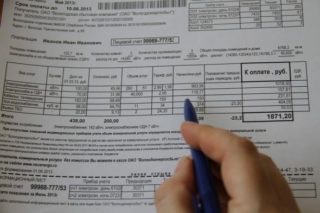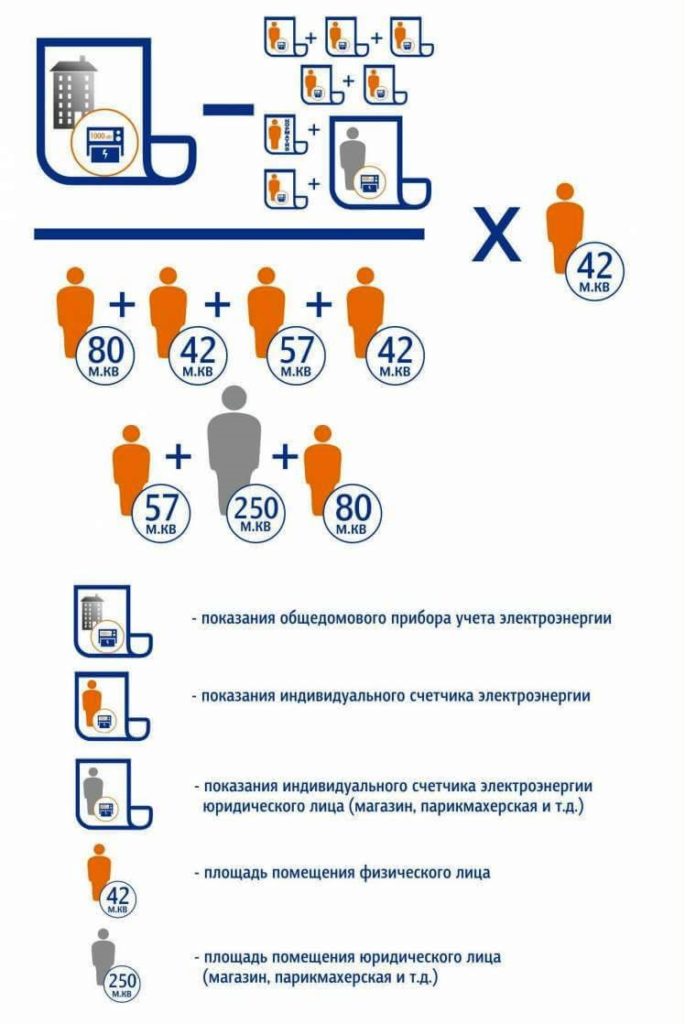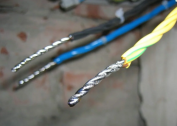In 2017, amendments were made to the procedure for compiling electric bills, which are defined as expenses for general house needs (according to the accepted classification - “ONE for electricity”). After such an adjustment, these costs were attributed to the category of expenses for the maintenance of property common to the entire city house. The upper bar of these charges (or consumption standard) is limited by the limits, the value of which was approved in the same 2017.
What is ONE for electricity
For example, we can consider the distribution of consumer goods inside an apartment building. They are conditionally distributed between two main items of expenditure:
- Payment by each tenant of the electric energy consumed within the limits of only their own apartment.
- General expenses for the needs of the whole house, distributed evenly among all residents.
The second component is the very common house needs that require more detailed consideration.
What is included in this category?
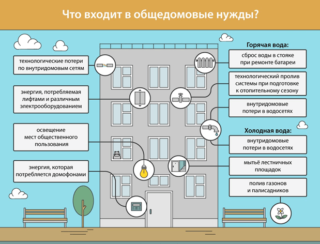 Electricity supply ONE includes expenses for payment of electricity consumed outside residential premises, which are individually attributable to each of the apartment owners. These primarily include the cost of lighting the following places:
Electricity supply ONE includes expenses for payment of electricity consumed outside residential premises, which are individually attributable to each of the apartment owners. These primarily include the cost of lighting the following places:
- common corridors, landings and vestibules;
- areas in front of the entrance;
- basements in the house and attics.
This also includes the costs of paying for the operation of elevators, intercoms, as well as surveillance cameras.
ONE also includes payment for power supply and maintenance of elements of communication devices (cable TV amplifiers and Internet networks, for example).
The list is supplemented by the power costs of the alarm systems installed in the entrance, common antenna amplifiers, as well as pumps and other equipment.
When calculating the ODN, the so-called "technological losses" associated with unproductive energy costs are taken into account. By this we mean not only the bulbs left not turned off, but also poor-quality contacts, which consume energy in the form of heat dissipated into space.
Accrual rate
The electricity charge included in the utility costs article, according to the laws adopted in the Russian Federation, is charged to the collective consumer at fixed rates. The exact numbers of the ONE standards for light in an apartment building are recognized from the list that takes into account the composition of the common property in it (SDI). Information on this property is provided on the Internet at the sites of specific energy companies. To get acquainted with it, just select your city, and then download the documents displayed in the issuing line.
These figures alone are not enough to obtain the final result on electricity ONE. To calculate it, you will have to use a special formula. It is important to pay attention to the fact that in the tables for a particular housing and communal services usually two figures are given: one taking into account the payment for the elevator, and the second without it. Further actions depend on the goals that the user has set for himself.
How to calculate ONE for electricity
Before counting the ONE in the city house by the counter, you will need to familiarize yourself with the formula for its calculation. It is based on the total footage and tariff applicable in the area. For the current 2019, the calculation technique and the formula itself used in this case practically did not change.When applying it, it is assumed that a common meter is installed in the city house, as well as that each apartment has its own individual meter.
In this case, the calculation formula by which payment should be charged takes the following form:
Vi od = (V rev - Σu Vu len. - Σv Vv cond.n .-- Σu Vw con.p. - V cr) × (Si ∕ S rev)where
- V about - numbers of readings taken from a meter common to the house,
- Vu tender - the amount of energy spent in rooms considered non-residential,
- Vv living - consumption attributable to individual housing that does not have its own meter,
- Vw housing - consumption in apartments equipped with an individual meter,
- V cr - part of the energy consumed for heating needs and hot water supply (for houses to which centralized networks are not connected).
Si represents the area of a separate apartment, and S - the total footage of all such premises in a particular house.
Calculation example for a multi-storey building
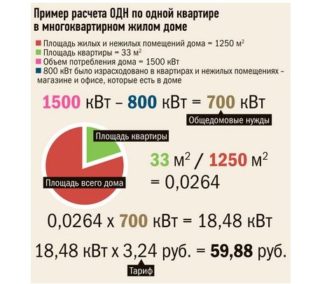 An example of calculating ONE for one residential building located in an apartment building without a common meter is considered.
An example of calculating ONE for one residential building located in an apartment building without a common meter is considered.
From the sources is the normative value of electricity consumption at ONE for residents of apartment buildings with common appliances installed in them. At tariffs in force in most regions of the Russian Federation, this figure is 3.94 kilowatts / hour (based on 1 square meter of common area per month).
Let the footage of all the premises that make up the common property of this apartment building be equal to 1400 square meters. The total area of a separate apartment is, for example, 60 square meters. meters. The footage of all residential and non-residential premises in this apartment building corresponds to the figure of 2400 sq. meters.
If you calculate the amount that all residents will have to pay on ONE - it will be equal to 3.94x1400 x 60/2400 = 140.0 kW / hour (approximately). Applying the formula for recalculating this item of expenses for one apartment to the obtained result, we get: 140,461х1,936 = 271.93 rubles.
The coefficient 1.936 is determined in a practical way for a typical apartment building.
In real conditions, the fee for ONE according to the initial standard (when access meters are either faulty or absent) is significantly higher than the same indicator obtained with a working common device. Therefore, almost all residents of an apartment building are interested in installing it and maintaining it in working condition.
Ways to reduce ODN
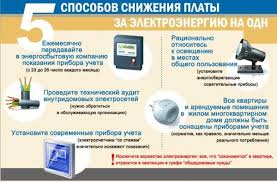 To solve this issue, the simplest approach has traditionally been applied, which involves reducing unproductive energy costs if they do not fit the norm. They are understood as the costs of lighting stairwells and areas near waste bins, which may not be turned off throughout the day. This also includes unjustified leakage of electrical resources in the joints of individual circuits due to poor contact in them.
To solve this issue, the simplest approach has traditionally been applied, which involves reducing unproductive energy costs if they do not fit the norm. They are understood as the costs of lighting stairwells and areas near waste bins, which may not be turned off throughout the day. This also includes unjustified leakage of electrical resources in the joints of individual circuits due to poor contact in them.
Unjustified costs in this case are manifested in the form of heat loss dissipated into the surrounding space idle.
To reduce the cost of ONE in any apartment building, the following actions must be taken:
- install in the public places of lighting (in corridor spans and on platforms) circuit breakers - photo sensors or presence sensors;
- if it is impossible to use technical means, organize the mode of individual use of light;
- collectively pay for the work of an electrician to check all the connections in the general wiring and keep the contacts in good condition.
With very worn wiring, replacement of dilapidated sections requires a new cable.
All of the above measures will help to support the cost of ONE within the framework of standardized indicators.
If the volume of ONE is negative
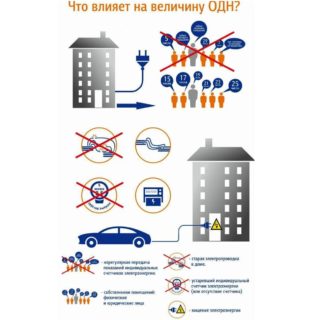 If, according to the total amount, all tenants spent exactly the amount of electricity that was written off according to the total meter, this means that nothing was spent on ONE.It turns out that each of the residents living in the house does not need to pay anything under this heading.
If, according to the total amount, all tenants spent exactly the amount of electricity that was written off according to the total meter, this means that nothing was spent on ONE.It turns out that each of the residents living in the house does not need to pay anything under this heading.
If the amount presented for payment turned out to be negative - a larger amount was accrued to the residents of the house than actually consumed - the difference must be debited from their accounts. When this difference is positive, it is equally distributed among all residents of the house, obliged to pay it according to the receipt on ONE.
The situation with a negative balance in ONE usually develops in cases where there are no meters in several apartments of a particular house. At the same time, the payment charged to the residents of these apartments includes common house expenses, although the actual consumption under this item is less. The resulting electricity supplier should calculate the negative difference by dividing the excess (overpayment) between all apartment owners.
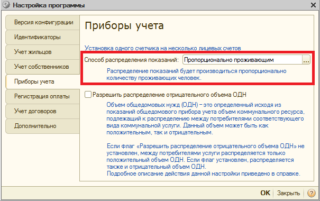
When recalculating, the consumption value is proportional to the number of residents living in the apartment without an electric meter or the size of its total area in sq. M. m. The specified procedure is clearly spelled out in article No. 354 of the government decree. Based on it, after a negative balance for a given utility service is found in the receipt, it is immediately concluded that this is a recalculation of the fee.
This case is clearly illustrated by the following example. Let the difference between the readings of the general electricity meter and taken from all apartments amounted to 130 kW / h. If the total number of inhabitants in this house is 150 people, the detected difference in payment is distributed as follows: -130 / 150 = -0.87 kW / h. Suppose that in an apartment with three residents registered in it for the current month, 100 kW / h has been used up (this number does not include housing without a meter). As a result of the recalculation, the amount of energy consumed by each personal owner will decrease by 3x0.87 = 2.61 kW / h. If this rule (as well as all others) is not observed when calculating ONE, deprived tenants have the right to resolve the issue through an appeal to local courts. After the decision by the relevant authorities in favor of the applicant, it will also be possible to cancel it only through the court.
Most of the ONE, which have to pay the residents of the house, can be attributed to the cost of lighting the porches and areas near the house. Following on this indicator are various types of equipment (heating pumps and elevators). A smaller share is the cost of electrical equipment used in the repair work.
